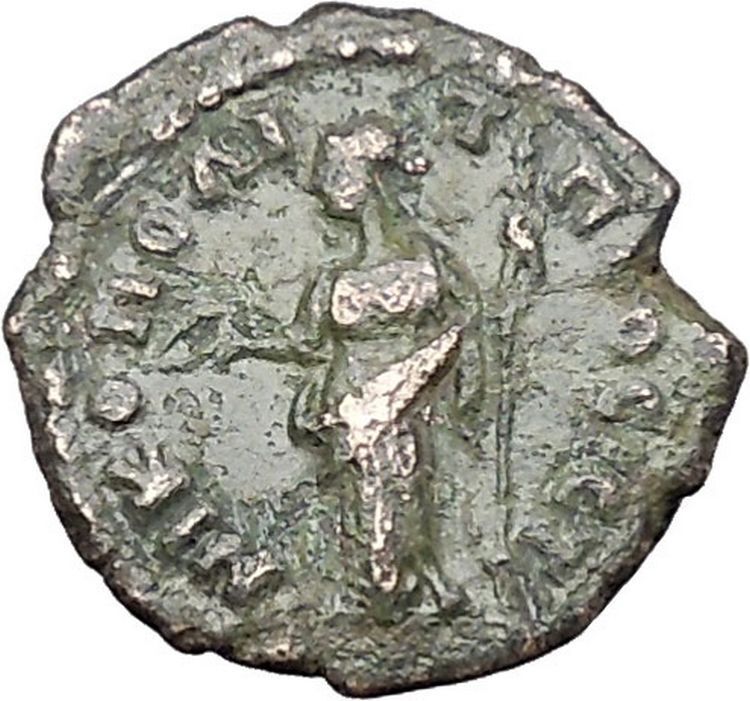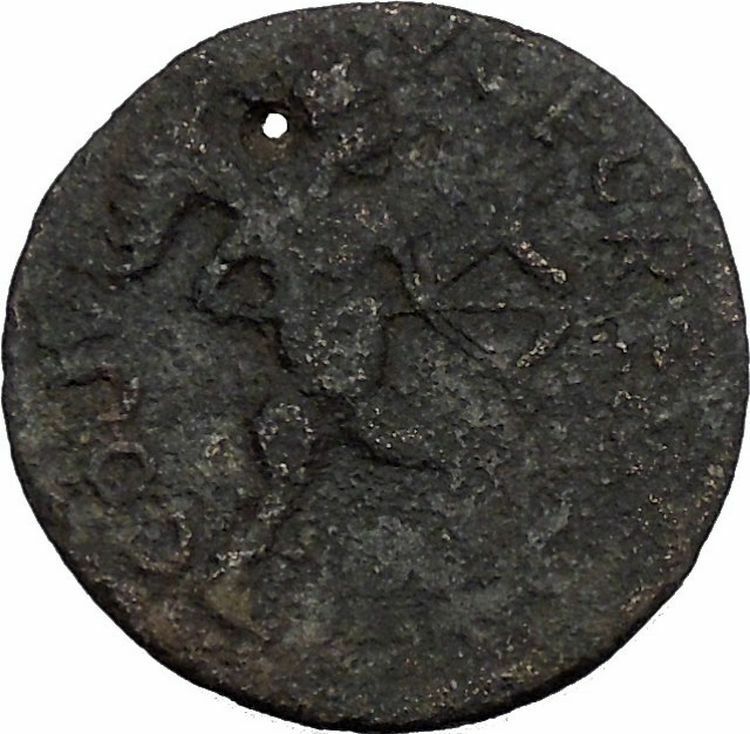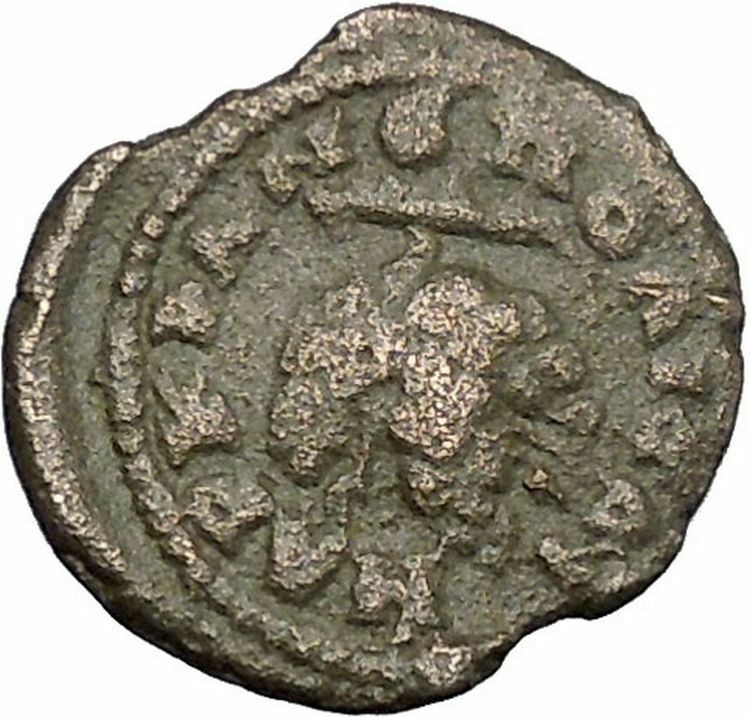|
Constantius Gallus – Roman Caesar: 351-354 A.D.
Gladiator Style Battle Scene Coin
Bronze AE2 23mm (3.90 grams) Siscia mint:, struck circa 351-354 A.D.
Reference: RIC VIII 347
D N CONSTANTIVS IVN NOB C, bare-headed, draped, cuirassed bust right.
FEL TEMP REPARATIO / I/BSIS•S, Roman soldier standing left, spearing a bearded fallen horseman, who reaches back towards soldier.
FEL TEMP REPARATIO translates to “Happy days are here again”. It was during the reign of Constantius II that the 1100th anniversary of Rome was celebrated, around 348 A.D., as emperor Philip I did over 100 years ago for the 1000th Anniversary of Rome in 248 A.D., where he depicted on his coins the various animals paraded through the Colosseum from all over the Roman empire. Being a fan of gladiators, just like many emperors before him, Constantius II, possibly chose to depict the climax of gladiatorial combat scene where one opponent slays the other, thus giving an interpretation of a gladiator style battle scene. Such a scene would have been a spectacle all of Rome would come to see at the Colosseum of Rome and many other arenas, especially during celebrations of Rome’s anniversary. Arena translates to sand, and it took a lot of it to soak all the blood spilt in this very bloody sport. The other purpose of such a coin reverse would have been to intended to boost morale of the Roman empire showing what is clearly a Roman soldier being victorious over even what could be considered a better-equipped horse-mounted soldier. As can be seen in the movie Gladiator, there are scenes where there are battles re-created of Roman soldiers defeating barbarians. The coins of the various Roman emperors would have been the best communication medium for the entire empire, and a great way to advertise the might and the power of the Roman empire by such a coin. An interesting, historically significant ancient Roman coin.
You are bidding on the exact item pictured, provided with a Certificate of Authenticity and Lifetime Guarantee of Authenticity.
A gladiator (Latin: gladiator, “swordsman”, from gladius, “sword”) was an armed combatant who entertained audiences in the Roman Republic and Roman Empire in violent confrontations with other gladiators, wild animals, and condemned criminals. Some gladiators were volunteers who risked their lives and their legal and social standing by appearing in the arena. Most were despised as slaves, schooled under harsh conditions, socially marginalized, and segregated even in death.
Irrespective of their origin, gladiators offered spectators an example of Rome’s martial ethics and, in fighting or dying well, they could inspire admiration and popular acclaim. They were celebrated in high and low art, and their value as entertainers was commemorated in precious and commonplace objects throughout the Roman world.
The origin of gladiatorial combat is open to debate. There is evidence of it in funeral rites during the Punic Wars of the 3rd century BC, and thereafter it rapidly became an essential feature of politics and social life in the Roman world. Its popularity led to its use in ever more lavish and costly games.
The gladiator games lasted for nearly a thousand years, reaching their peak between the 1st century BC and the 2nd century AD. The games finally declined during the early 5th century after the adoption of Christianity as state church of the Roman Empire in 380, although beast hunts (venationes) continued into the 6th century.

Pollice Verso (“With a Turned Thumb”), an 1872 painting by Jean-Léon Gérôme

Part of the Gladiator Mosaic, displayed at the Galleria Borghese. It dates from approximately 320 AD. The Ø symbol (possibly Greek theta, for thanatos) marks a gladiator killed in combat.
Flavius Claudius Constantius Gallus (ca. 325/326 – 354), better known as Constantius Gallus, was a member of the Constantinian dynasty and Caesar of the Roman Empire (351-354). Gallus was consul three years, from 352 to 354.
Son of Julius Constantius by his first wife Galla, Gallus’ paternal grandparents were Western Roman Emperor Constantius Chlorus and his second wife Flavia Maximiana Theodora.
Julius Constantius was also a half-brother of Roman Emperor Constantine I, and thus Gallus was a first cousin of Emperors Constantine II, Constantius II and Constans.
The older sister of Gallus, of unknown name, was the first wife of Constantius II. Julius Constantius had married a second wife, Basilina, who had borne him a son, Flavius Claudius Iulianus, later emperor, and known as Julian.
In 350, Magnentius had rebelled and killed the emperor Constans, claiming the purple. Constantius II prepared to move against the usurper, but needed a representative in the East, so he called Gallus at Sirmium, raised him to the rank of caesar (15 March 351), gave him the name Constantius, and strengthened the bonds with his cousin by allowing Gallus to marry his sister Constantina. Gallus and Constantina, who probably shared her brother’s aim of controlling the young caesar, set up residence in Antioch.
During his rule, Gallus had to deal with a Jewish rebellion in Judea/Palestine (see War against Gallus). The rebellion, possibly started before Gallus’ elevation to caesar, was crushed by Gallus’ general, Ursicinus, who ordered all the rebels slain.
Gallus was saved from an assassination plot by a woman, who revealed that some members of her household were planning the murder. Some sources, among whom are Joannes Zonaras, claim that this plot had been organized by Magnentius in order to distract Constantius from Magnentius himself.
Some sources (Philostorgius) claim Gallus’ generals won a campaign against the Sassanids. Others, basing their views on an almost-peaceful situation between Sassanids and Romans, dismiss this claim. In 354, Gallus sent the Comes Orientis, Nebridius, against the Isaurians, who had been raiding the city of Seleucia on the Tigris.
As a consequence of the need to gather food for the troops of a Persian campaign or because of drought, the grain supply in Antioch decreased. In order to counter the higher price of grain, Gallus forced the passage of some laws regardless of the opinion of the Senate, thus alienating the support of the senatorial class of Antioch. Ammianus Marcellinus, a philo-senatorial writer, tells how the anger of the people of Antioch for the famine was diverted by Gallus towards the consularis Syriae Theophilus, who was killed by the mob.
Ammianus reports also that Gallus and Constantina started several trials for magic against wealthy people, ending in the execution of innocents and in the confiscation of their wealth. The same source claims that Gallus walked anonymously in Antioch by night, asking passersby for their opinion on their caesar, while Julian records the great amount of time spent by Gallus at the Hippodrome, probably to obtain popular support.
Doubting his cousin’s loyalty, Constantius reduced the troops under Gallus, and sent the Praetorian Prefect Domitianus to Antioch to urge Gallus to go to Italy. Different sources tell different stories, but all agree that Gallus arrested Domitianus and the quaestor Montius who had come to his aid, and that the two officers were killed.
The arrest of Montius led to the discovery of what seems to be a plot to elevate an usurper against Gallus. The conspirators had the support of two tribuni fabricarum (officers of the weapons factories) who had promised the weapons for an uprising (Ammianus Marcellinus, 14.7.18), and probably of the troops in Mesopotamia, as well as of the rector of the province of Phoenice. All of those involved in the plot were sentenced to death.
Constantius was informed of the trials in Antioch during a campaign against the Alamanni. Having signed a peace with the Germanic tribe, Constantius decided to settle the matter with his cousin. First he summoned Ursicinus to the West, whom he suspected to have been inciting Gallus in order to create the occasion for a revolt and the usurpation of his own son.
Next, Constantius summoned Gallus and Constantina to Milan. Constantina left first, in order to gain some of her brother’s trust, but died at Caeni Gallicani in Bithynia. Gallus, whose bonds to Constantius had been weakened, stayed in Antioch. Constantius tried to lure Gallus, sending the tribunus scutariorum Scudilo to tell Gallus that Constantius wanted to raise him to Augustus. Gallus desiring to finally obtain the rank of Augustus, took Constantius’s bait and left Antioch to meet him. Gallus in an exhibition of his presumed soon to be Augustus powers, staged a chariot race in Constantinople’s Hippodrome and crowned the victor, an honor reserved only for those that are Augustus. This insolence of Gallus enraged Constantius, further adding to his dislike for the upstart Caesar. In an attempt to further isolate Gallus from any form of military protection, Constantius had the garrisons removed from the towns in Gallus’s path.
When Gallus arrived to Poetovio in Noricum, Barbatio, an officer who had been supporting Gallus’ dismissal within Constantius’ court, surrounded the palace of the caesar and arrested him, stripping Gallus of the imperial robes, but assuring him that no harm would come to him. Gallus was led to Pola, Istria (now Pula, Croatia). Here he was interrogated by some of the highest officials of Constantius’ court, including the eunuch praepositus cubiculi Eusebius and the agens in rebus Apodemius. Gallus tried to put the blame of all of his actions on Constantina, but Constantius sentenced him to death; The emperor later changed his mind, and ordered the caesar to be spared, but Eusebius ordered that the news was not to reach the executioners.
|












